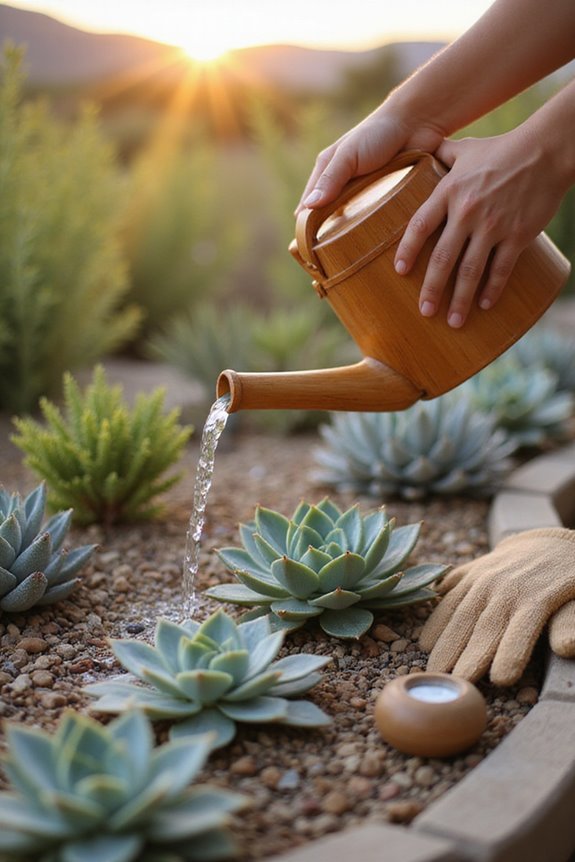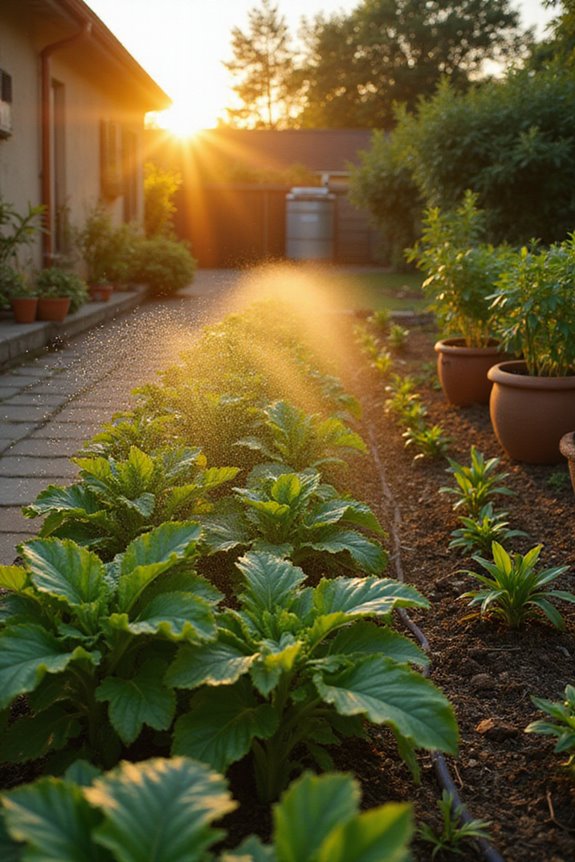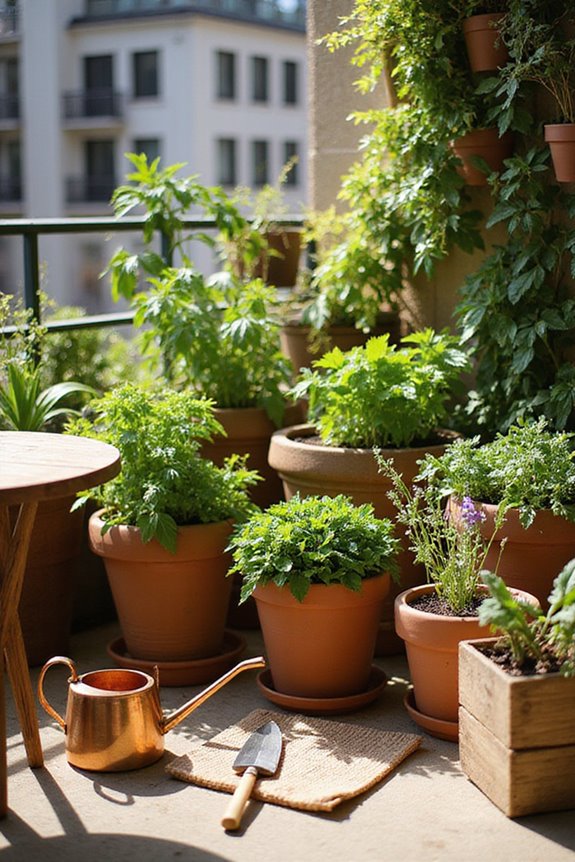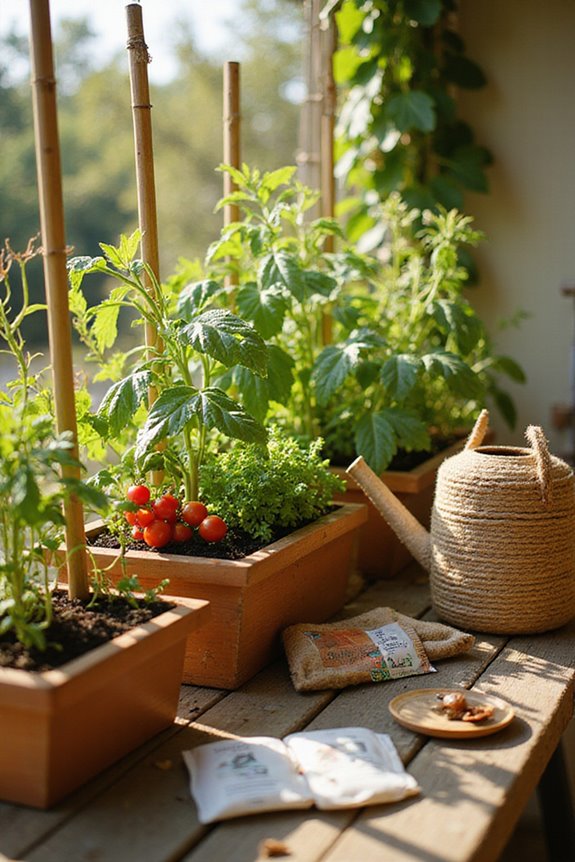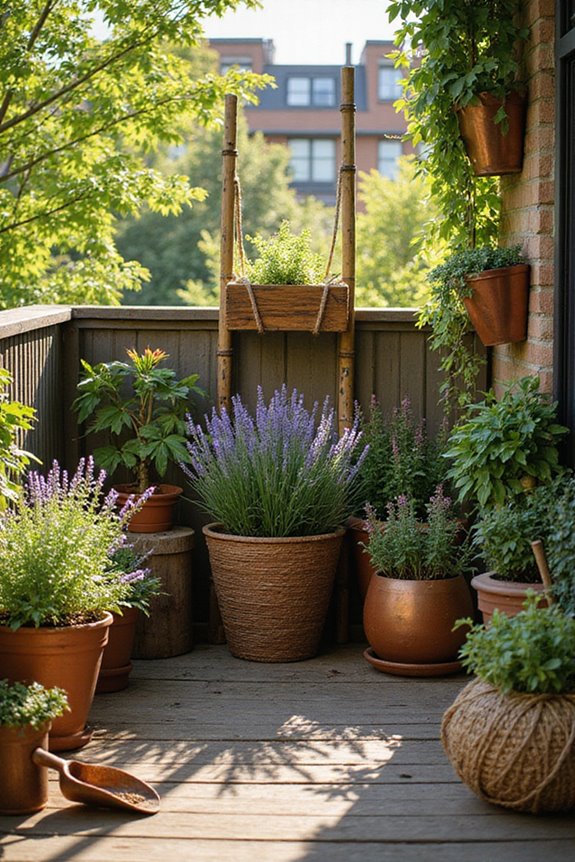To water drought-tolerant plants, we should focus on deep watering techniques. This encourages strong root growth, helping plants access moisture efficiently. Let’s aim to water in the morning before 7:00 am to reduce evaporation. For established plants, deep watering less frequently works best, while young plants need regular deep watering for the first couple of seasons. To maximize our success, we’ll also want to check soil moisture and consider effective mulching practices. There’s more to learn about maintaining these plants.
Key Takeaways
- Water deeply and infrequently to encourage strong root development and access to deeper moisture.
- Water young plants regularly and deeply for the first one to two growing seasons.
- Water in the morning before 7:00 am to minimize evaporation and ensure adequate hydration.
- Prepare soil with organic matter for better moisture retention and drainage.
- Use mulch to retain moisture, suppress weeds, and improve soil health around plants.
Understanding the Watering Needs of Drought Tolerant Plants
When it comes to watering drought tolerant plants, understanding their specific needs is essential for healthy growth. We’ve learned that deep watering encourages root depth, allowing plants to access moisture deeper in the soil. This practice increases plant resilience, especially during dry spells.
- Shallow watering leads to weak, shallow roots that depend on surface moisture.
- Established plants thrive with deep, infrequent watering, while young plants need regular deep watering for the first one to two growing seasons.
Timing Your Watering Sessions
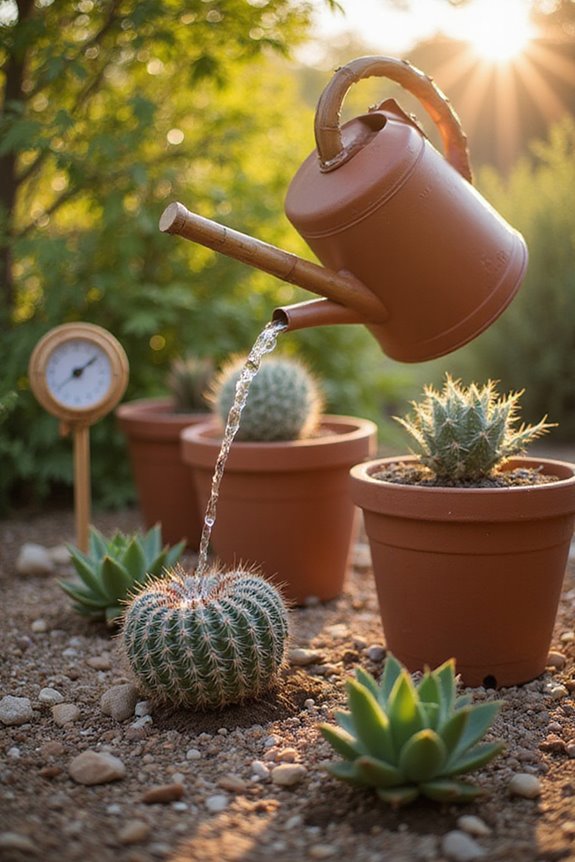
How can we guarantee our drought-tolerant plants get the right amount of water? Timing is key. Morning watering, ideally before 7:00 am, helps reduce evaporation and prepares our plants for the day. This early routine assures they get the hydration they need without losing much to the sun.
Evening watering can cool our plants but isn’t the best choice. Water sitting on leaves overnight can lead to fungal diseases.
Here are some tips for timing our watering sessions:
- Water early: Aim for mornings.
- Avoid midday: The heat causes rapid evaporation.
- Be cautious with evening watering: It can promote diseases.
Benefits of Deep Watering
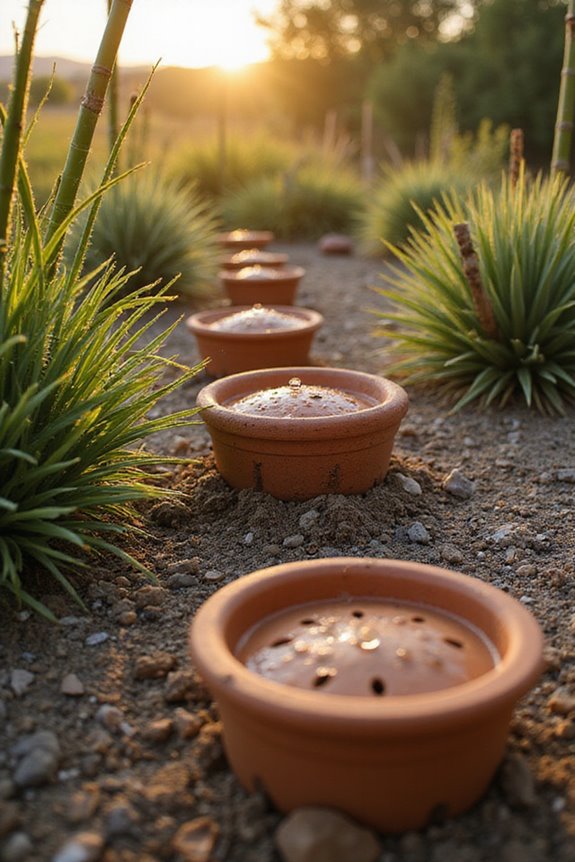
Deep watering offers numerous benefits that can greatly enhance the health and resilience of our drought-tolerant plants. First, it promotes strong root development. Deeper roots help plants access water and nutrients that are out of reach for shallow-rooted varieties. This stability makes them more resistant to harsh weather conditions.
Secondly, deep watering improves moisture retention within the soil. Water stored deep is less likely to evaporate, ensuring a longer supply during dry spells. This efficiency reduces our need for frequent watering.
Finally, deep watering supports overall plant health. By encouraging robust roots, we help our plants better withstand temperature extremes and stress. Together, these benefits create a sustainable landscape that thrives even in challenging conditions.
Soil Preparation and Moisture Checking
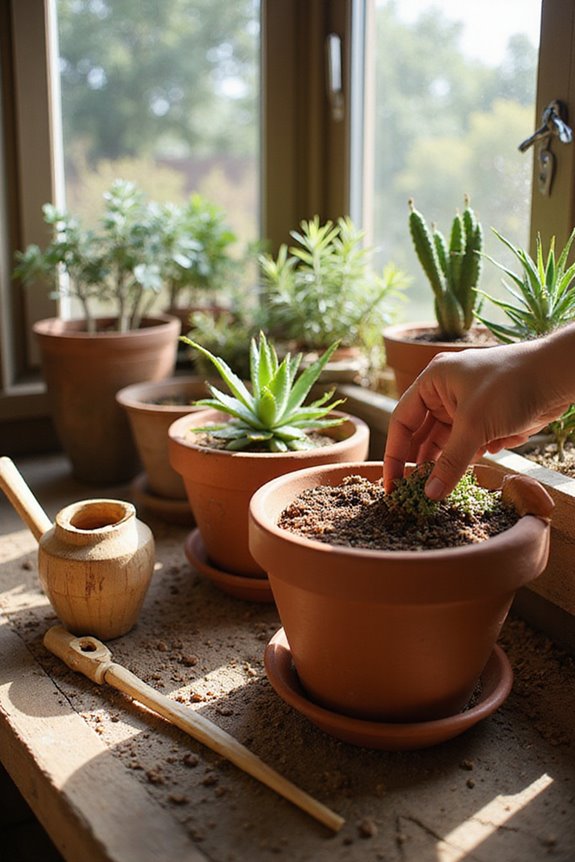
Preparing the soil properly is essential for the success of drought-tolerant plants. A good soil composition is key. We should mix 1/3 organic potting soil, 1/3 rotted manure, and 1/3 compost. This blend improves water retention and nutrient availability.
Next, let’s focus on drainage techniques. Proper drainage is vital to prevent waterlogging, which can harm roots. We can incorporate organic matter to enhance soil texture and air flow. Tilling or aerating compacted soil also helps roots penetrate better.
Finally, we must check soil moisture regularly. Using moisture meters or finger testing can guide our watering schedule. Monitoring moisture below the surface guarantees our plants receive the right amount of water. Together, these steps will promote healthy, drought-tolerant gardens.
Effective Mulching Practices
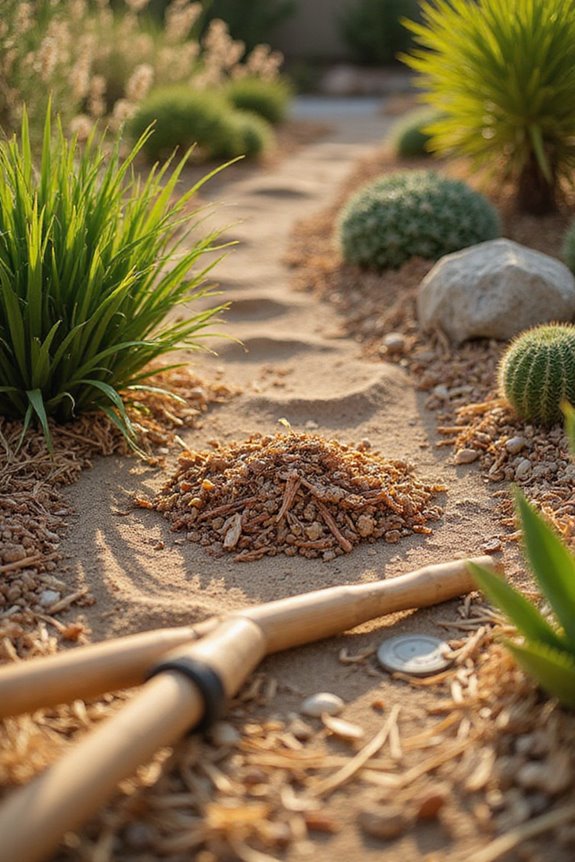
After ensuring our soil is well-prepared and moisture levels are monitored, we can enhance the effectiveness of our drought-tolerant gardens through mulching. Effective mulch materials include wood chips, straw, and grass clippings. These options help retain moisture, suppress weeds, and improve soil health as they decompose.
When applying mulch, we should use proper mulching techniques. Aim for a depth of 2 to 3 inches, keeping a 4-inch clearance around plant bases to prevent rot. Water the soil before mulching to maximize moisture retention. Thicker layers work well in landscape beds, while lighter layers are better for seedlings. Additionally, applying mulch contributes to improving soil health by adding organic matter as it breaks down. By following these practices, we can create a thriving, water-efficient garden that benefits us all.
Efficient Irrigation Methods
When we think about maintaining a drought-tolerant garden, efficient irrigation methods play an essential role. One of the best options is drip irrigation. This system delivers water directly to plant roots, reducing evaporation and runoff by up to 30%. It’s perfect for our clustered plants, promoting healthy growth and conserving water.
Another great approach is smart irrigation. Using sensors and weather data, this method adjusts watering schedules based on real-time conditions. This guarantees our plants receive just the right amount of water, enhancing conservation and boosting yields. Additionally, implementing drip irrigation systems not only saves water but also encourages optimal plant health by targeting the roots directly.
Implementing Water Conservation Strategies
Implementing water conservation strategies is essential for maintaining a healthy drought-tolerant garden. First, we should focus on plant selection. Choosing native, drought-tolerant plants that thrive in our local climate guarantees better water conservation. Next, we can enhance soil health with organic soil amendments like compost, which improves water retention. Additionally, we should avoid over-tilling to maintain soil structure and utilize mulch. Applying 1-2 inches of organic mulch around plants reduces evaporation and keeps soil cool. Furthermore, incorporating native plants can enhance garden aesthetics while providing habitat and food for local wildlife. Lastly, monitoring soil moisture helps us avoid over- or under-watering. By grouping plants with similar water needs, we can streamline our watering practices. Together, these strategies will create a sustainable garden that conserves water effectively.
Frequently Asked Questions
Can I Use Rainwater for Watering Drought Tolerant Plants?
Absolutely, we can use rainwater for our drought-tolerant plants! By embracing rainwater harvesting, we boost plant health while conserving resources. Together, we’ll create resilient landscapes that thrive naturally, benefiting both our gardens and the environment.
What Signs Indicate My Drought Tolerant Plants Need Water?
When we notice leaf wilting and check the soil moisture, it’s essential to act. If the leaves droop consistently and the soil feels dry, we understand our drought-tolerant plants need some extra care.
How Do I Choose Drought Tolerant Plants for My Garden?
When we’re selecting drought-tolerant plants, it’s like picking our favorite team. We need the right plant types for our soil selection, ensuring they thrive together, creating a beautiful, resilient garden that unites us with nature.
Can I Water Drought Tolerant Plants With a Hose?
Absolutely, we can use hose watering techniques for our drought plant care! By watering slowly and focusing on the soil, we can promote strong roots and help our plants thrive during dry spells together.
Is It Safe to Water Drought Tolerant Plants With Reclaimed Water?
As we nurture our gardens with reclaimed water, we embrace a sustainable future. By carefully choosing drought-tolerant plants, we can guarantee their health thrives, enjoying the beauty of nature while prioritizing reclaimed water safety for all.

